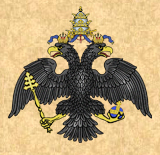|
 USE OF THE ANTIMENSION The
use of the antimension is approved for all rites under the jurisdiction
of this Apostolic See. When used, the antimension itself is considered
the altar. In the Gallo-Russo-Byzantine Rite and Anglican-Byzantine
Rite, it may be used as follows: 1. In place of or in addition to an altar stone.
2. It should most probably contain at least one relic.
3.
It is kept folded in the centre of the altar and is folded in the
same manner as a corporal. If it is too long to fit entirely on the top
of the altar, it may hang somewhat over the front as long as it is thus
secure.
4. Before the placing of the gifts, it is unfolded and laid in the centre of the altar by the priest.
5. The Corporal is then unfolded as usual on top of the antimension.
6. After the ablutions, the Corporal is folded as usual.
7. Once the Sacred Vessels have been removed, the antimension is refolded and left in the centre of the altar.
In the Anglo-Roman and Gallican Rites, the antimension may be used in
place of an altar stone, which is particularly useful for travel and ad
hoc settings. When it is used in those rites, it is likewise kept in
the centre of the altar and unfolded before the Sacred Vessels are
placed. (Thus, in the case of a low mass, it is unfolded before the
mass, and the Sacred Vessels are set upon it.) After the ablutions, the
Corporal is folded. Once the Sacred Vessels are removed, either after
the ablutions or after the mass, depending on the specific
circumstances given in the rubrics, the antimension is folded and kept
in the centre of the altar. Blessing the Antimension
The antimension is blessed as follows:
1.
In the Rite of Blessing and Consecrating an Altar as given in the
Rituale of this See, if the altar table is to be blessed at the same
time, then the full ritual is used. The antimension is blessed using
the same rite as for the altar stone, with obvious omissions.
2.
The bishop begins the ritual as usual, but in place of “stone”
says “antimension.” Otherwise, where the word “altar” is used for a
stone, it likewise is used for an antimension since an antimension is
itself an altar.
3. The antimension is still blessed with the five crosses traced with holy water.
4. For the burial of the relics, the same ritual is used, with the obvious omission of the mortar.
5.
Continuing with the ritual, the antimension is then blessed again
using five crosses of holy water rather than chrism, as used for a
stone.
6. The five points of incense are not
placed, but rather the bishop censes the antimension five times with
double swings in each of the five positions where the crosses were
traced in holy water, in the same order. This is followed by the Veni
Sancte Spiritus, during which the antimension continues to be censed by
the thurifer.
7. In the case that an antimension
will be blessed without the altar table as well, the full rite is
observed, except that the censing of the altar is omitted, since the
antimension is placed on a suitable table.
[Divine Liturgy]
[Main Page]
DISCLAIMER, LEGAL, AND COPYRIGHT NOTICES
|
